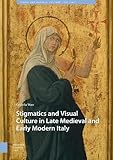Stigmatics and Visual Culture in Late Medieval and Early Modern Italy / Cordelia Warr.
Material type: TextSeries: Visual and Material Culture, 1300 –1700 ; 38Publisher: Amsterdam : Amsterdam University Press, [2022]Copyright date: ©2022Description: 1 online resource (316 p.)Content type:
TextSeries: Visual and Material Culture, 1300 –1700 ; 38Publisher: Amsterdam : Amsterdam University Press, [2022]Copyright date: ©2022Description: 1 online resource (316 p.)Content type: - 9789048554621
- online - DeGruyter
| Item type | Current library | Call number | URL | Status | Notes | Barcode | |
|---|---|---|---|---|---|---|---|
 eBook
eBook
|
Biblioteca "Angelicum" Pont. Univ. S.Tommaso d'Aquino Nuvola online | online - DeGruyter (Browse shelf(Opens below)) | Online access | Not for loan (Accesso limitato) | Accesso per gli utenti autorizzati / Access for authorized users | (dgr)9789048554621 |
Frontmatter -- Visual and Material Culture, 1300-1700 -- Table of Contents -- Acknowledgements -- List of Illustrations -- 1. Introduction: Stigmata and Visual Culture -- 2. Saint Francis of Assisi as Image -- 3. Representing the Invisible: Saint Catherine of Siena’s Stigmatization -- 4. The Stigmatic Spectrum and the Visual Arts -- 5. Gregorio Lombardelli, Invisibility, and the Representation of Saint Catherine of Siena’s Stigmata -- 6. Performing Stigmata -- 7. Painting, Printing, Sculpting, Forgery (and Washing) -- 8. Conclusion: The Timidity of the Visual Arts -- Complete Bibliography -- Index
restricted access online access with authorization star
http://purl.org/coar/access_right/c_16ec
This book places the discourse surrounding stigmata within the visual culture of the late medieval and early modern periods, with a particular focus on Italy and on female stigmatics. Echoing, and to a certain extent recreating, the wounds and pain inflicted on Christ during his passion, stigmata stimulated controversy. Related to this were issues that were deeply rooted in contemporary visual culture such as how stigmata were described and performed and whether, or how, it was legitimate to represent stigmata in visual art. Because of the contested nature of stigmata and because stigmata did not always manifest in the same form - sometimes invisible, sometimes visible only periodically, sometimes miraculous, and sometimes self-inflicted - they provoked complex questions and reflections relating to the nature and purpose of visual representation. Dr Cordelia Warr is Senior Lecturer in Art History, University of Manchester, UK.
Mode of access: Internet via World Wide Web.
In English.
Description based on online resource; title from PDF title page (publisher's Web site, viewed 29. Mai 2023)


